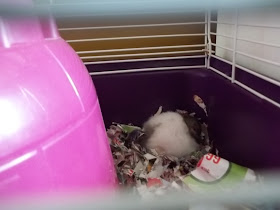 |
| A sample of the cool animals in the touch tank |
 |
| Coral, Sea Cucumber, and Sea Stars |
In the middle of this photo is a Sea Cucumber (the long, black, cylinder shaped animal). Without meeting this animal, it's hard to tell what it is or how it survives, but once you get up close you discover some really cool features! First of all, Sea Cucumbers are really soft and squishy. They are filled with lots of water and can change their body shape really easily. For example, if a Sea Cucumber wanted to fit into a tiny hole in a rock, it could squish its body into a small, thin shape and fit through!
In this photo, you can see the underside of the Sea Cucumber and see how it has changed it shape and size. The orange lines or dots that you can see are its feet! They are tiny "tube" feet, which means they can suction onto objects, like rocks, to walk along the sea floor.
Sea Cucumbers have many ways of keeping predators away from them. Sometimes, when vistors to the touch tank picked up a Sea Cucumber, it would squirt out water to make itself look deflated and confuse them into thinking it was dead. Most people jumped in surprise and thought that the animal was peeing on them! Some Sea Cucumbers also have a deadly chemical that they can squirt out (sort of like squid!) to kill any animals trying to eat them.
To eat, these cute squishy animals have a ring of tentacles (sort of like fingers) around their heads. These tentacles are sticky and sometimes a Sea Cucumber will point them up in the water and catch little bits of food that float by. They also like digging in the sand to find little food pieces. Their mouth is in the middle of the ring of tentacles.
Sea Cucumbers can be all sorts of different colors and patterns, like this cool bright blue one. I worked with animals that were dark black, with grey bellies, and orange tube feet.
P.S.: I've added a whole bunch of updates in the past few weeks: links to cute and fun games, craft tutorials (i.e. origami animal bookmarks, jellyfish mobile, zoo-themed board game), and a brand new Video page. Click on the pages above!






